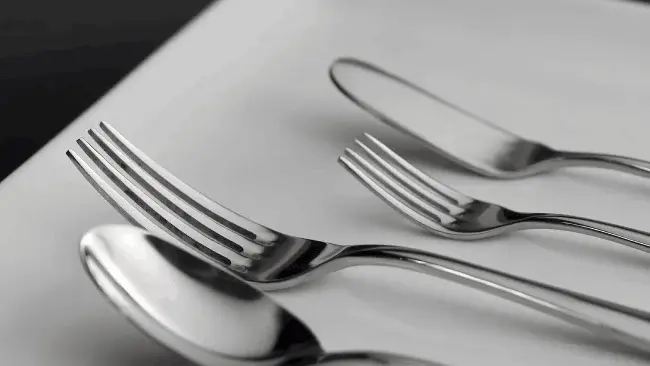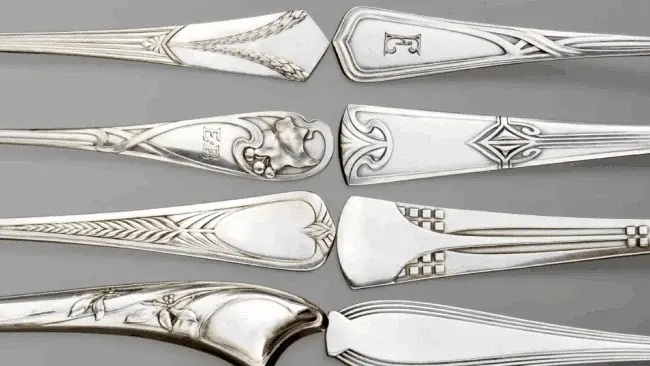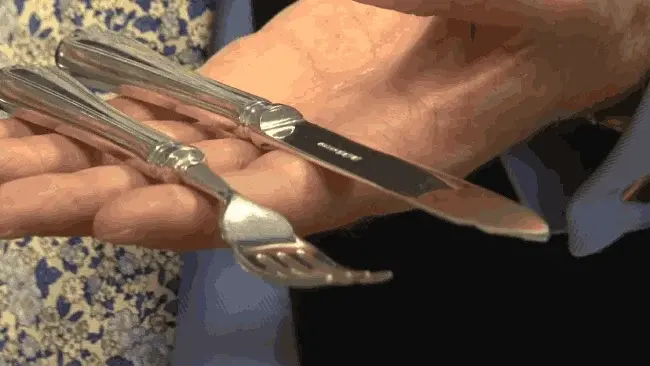Flatware patterns have evolved for centuries with unique designs that reflect different regions’ cultural, social, and economic backgrounds. However, identifying these patterns is not easy for collectors and enthusiasts. But you can identify different flatware patterns by following a few steps.
Begin by gathering your flatware set and examining the used material and marks on each piece if they have. Carefully inspect the design to determine its unique pattern. You can utilize online resources or expert assistance for further guidance in identifying your flatware patterns.
This article aims to instruct you through identifying flatware patterns so you can store them appropriately. We will also discuss different types of antique flatware patterns and their distinguishing features to determine your flatware’s value.
Jump to Section
How to Identify Flatware Patterns for Organizing in Kitchen Cabinets?

To properly store your flatware in an organizer, you must identify the patterns:
- Gather the flatware set
- Identify the material
- Examine the marks
- Inspect the design
- Check online resources
- Research the manufacturer
- Ask for expert help
Let’s take a closer look at these steps:
STEP 1. Gather the Flatware Set
Gather all the flatware pieces you want to identify and lay them on a clean, well-lit surface. Take your time to arrange the flatware systematically, grouping similar pieces. When laying out the flatware, ensure you’ve enough space to maneuver each piece and observe it closely.
STEP 2. Identify the Material
Take a closer look at the material of the flatware to determine if it’s sterling silver, silverplate, stainless steel, or another type.
Examine the flatware for any marks or hallmarks that indicate the material. Sterling silver flatware will typically have a mark indicating its silver content, such as ‘925’ or ‘Sterling.’ Conversely, silverplate flatware will have a mark indicating the company or manufacturer.
If no marks are present, you can use visual cues to differentiate between stainless steel and silver. Stainless steel flatware will have a more uniform and shiny appearance, while silver flatware may show signs of tarnish or discoloration.
STEP 3. Examine the Marks
Look closely at any marks on the flatware to gather important information about the manufacturer and pattern. These marks can be tiny and easily overlooked, but they hold valuable clues to help you identify your flatware pattern.
Manufacturers often stamp their name or logo onto the flatware, which can be a key identifier. The pattern name or number may also be engraved or etched onto the flatware. These marks are usually located on the back of the handle, the blade of a knife, or the back of the fork’s tines.
Take a magnifying glass to examine the marks and record any details carefully. Paying attention to these marks, you can piece together the puzzle and confidently identify your flatware pattern.
STEP 4. Inspect the Design
To determine the origin and style of your flatware, closely examine the overall shape, decorative elements, and unique design features. Pay attention to the intricate details that set it apart from other patterns. Look for patterns or motifs indicating a specific era or cultural influence.
For example, ornate floral designs are often associated with Victorian styles, while sleek and minimalistic patterns may suggest a more modern design.
Take note of any scrollwork or engravings that add texture and character to the flatware. Also, look for specific shapes or forms that aren’t commonly found in other patterns.
STEP 5. Check Online Resources
You can utilize online resources (like Replacements.com and SilverCollecting.com) to search for the manufacturer’s name, pattern name, or number to gather more information about the history and style.
These websites have extensive databases of flatware patterns, so you can find out what pattern you have.
STEP 6. Research the Manufacturer
Enter the manufacturer’s name or pattern number into the search bar and browse the results. You may be able to find detailed descriptions, images, and even historical information about the pattern provided by the manufacturer.
Also, these websites often provide helpful tips and guides on identifying and authenticating flatware patterns according to the manufacturer.
STEP 7. Ask for Expert Help
Now that you’ve researched the manufacturer and still haven’t been able to identify the pattern of your flatware, it’s time to seek the assistance of experts in the field.
There are numerous flatware collecting forums and social media groups where you can connect with enthusiasts with extensive knowledge and experience in identifying patterns. These experts can provide valuable insights and guidance based on your photos or descriptions.
They may be able to recognize specific details or characteristics that can help pinpoint the pattern. Be prepared to provide clear and detailed photographs of the flatware from different angles and any markings or distinguishing features.
Types of Antique Flatware Patterns & Their Features
You should be familiar with a few different styles of antique flatware patterns.
1. Victorian Flatware Patterns (1830 – 1900)

You can easily identify Victorian flatware patterns by their intricate floral and animal forms with Chinese or Gothic motifs. These patterns were widely used from 1830 to 1900 in the Victorian era.
Victorian flatware features intricate designs like flowers, leaves, and vines and animals like birds, butterflies, and dragons. Chinese and Gothic influences can be seen in the patterns’ use of pagodas, temples, and arches.
The craftsmanship of Victorian flatware is exceptional, with attention to detail and a sense of artistry. The pieces are typically made of 90% silver, giving them a luxurious and elegant appearance.
Some popular Victorian flatware patterns include Albert, Victoria, Princess, Devonshire, and Coburg.
2. Art Nouveau Patterns (1870 – 1900)
The intricate designs of Art Nouveau incorporate natural motifs like flowers, leaves, vines, and fruits, giving them a distinct and elegant look. Consider the asymmetrical designs and curved stems when identifying Art Nouveau flatware patterns.
These patterns often have deep bowls and superior Sterling silver bodies and handles. Some collectible Art Nouveau designs include Francis, Poppy, and Narcissus.
3. Art Deco Style (1920 – 1930)
Art Deco flatware patterns feature stream-lined geometric or floral designs with grooves and embossed finishes, usually with metallic chrome or nickel accents. These patterns were popular during the 1920s and 1930s, reflecting the sleek and modern aesthetic of the Art Deco movement.
The geometric designs often feature bold lines and angles, giving the flatware a futuristic and avant-garde appearance. Floral patterns, on the other hand, embrace organic shapes and intricate detailing.
4. Mid-Century Modern Patterns (1940 – 1960)
In the mid-century modern period, you’ll find flatware with machine-cut triangles, squares, and hexagons, giving them a sharp and angular appearance. These patterns reflected the design aesthetic from the 1940s to 1960s, characterized by clean lines and geometric shapes.
The machine-cutting process allowed for precise and consistent shapes, resulting in a sense of modernity and sophistication of flatware. These faceted edges added an extra layer of visual interest, creating a play of light and shadow.
5. Lily Pattern (1902 1926)
Let’s talk about the gorgeous Lily pattern created between 1902 and 1926. This opulent flatware design showcases intricate meshed florals, vines, and scrolls, a true feast for the eyes.
When identifying the original pieces from this period, you’ll notice the Whiting mark, characterized by a Lion passant with its paw on the letter ‘W’.
The handles of the Lily pattern display a stunning curved design, often adorned with buds or floral motifs. These collectible flatware patterns are typically fashioned from superior Silver, Sterling Silver, or gold-plated sides.
FAQ’s: How to Identify Flatware Patterns
How do I identify old & antique silver flatware?
You can easily identify old and antique silver flatware by examining the silver hallmarks stamped on each piece. These hallmarks are like a secret code containing valuable information about the piece’s origin and authenticity.
For example, a lion passant denotes that the piece is made of sterling silver, while a crown indicates it was assayed in England. Other marks can reveal the maker’s mark, date letter, and city mark, providing vital clues to the age and provenance of the flatware.
What are the most valuable sterling flatware patterns?
To truly appreciate the value of your sterling silver flatware, understand which patterns are considered the most valuable. One such pattern is the Grand Baroque by Wallace.
Produced by Wallace Silversmiths, this pattern is highly sought by collectors and enthusiasts alike. The Grand Baroque features a lavish and intricate design; ornate scrolls and floral motifs adorn each piece.
This pattern’s attention to detail and craftsmanship make it a standout among other sterling silver flatware patterns. Its timeless elegance and rarity contribute to its high value in the market.
How do I know if my flatware is valuable?
If your silverware has a rare or unique pattern engraved, it holds a higher value. One way to determine your flatware’s value is by carefully examining the pattern.
Look for intricate designs or patterns that aren’t commonly found. Collectors often seek these rare patterns and can fetch a higher price in the market. Also, consider the condition of your flatware. Pieces in excellent condition with minimal wear and tear are more valuable.
How to tell if silver flatware is antique?
Check for any hallmarks or stamps on the silverware, as these can indicate the age and authenticity of the piece. When identifying antique household silver flatware, these marks are crucial.

Look for imprints that read ‘STER’, ‘92.5%’, or ‘925’. These marks signify the silver’s purity, with ‘925’ indicating that it’s made up of 92.5% pure silver.
Also you should also examine the style and design of the flatware. Antique silver flatware often showcases intricate patterns and ornate details that reflect the craftsmanship of a bygone era.
Conclusion
Identifying flatware patterns is a fascinating journey that requires patience, attention to detail, and an analytical perspective. With proper resources, anyone can locate different flatware patterns for collection, inventory, or appraisal purposes.
Using the steps outlined above, you can confidently determine the material and manufacturer of your flatware and discover its unique design and pattern.
With your newfound expertise, you’ll confidently navigate the flatware world, discovering valuable patterns. Store sterling silver flatware and bring timeless elegance to your table.





